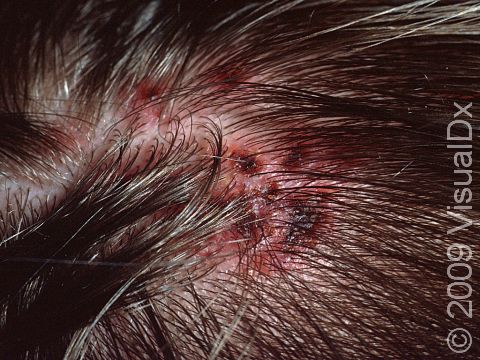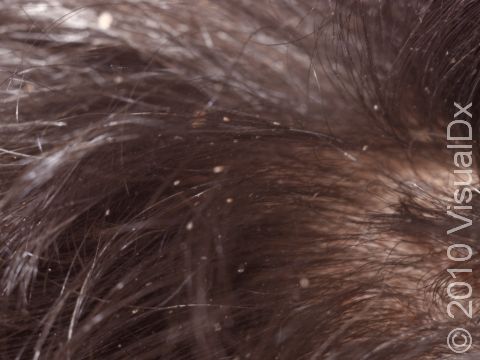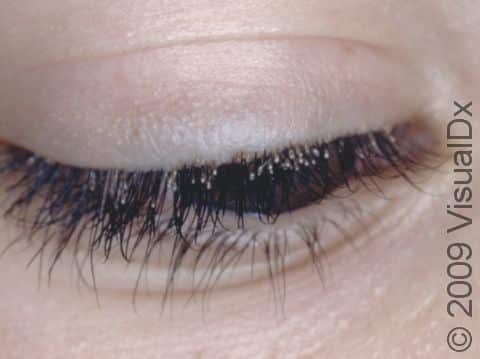Head Lice (Pediculosis Capitis)
Head lice (pediculosis capitis) is an infestation of the human head louse, which results in intense itching on the scalp. The itching is the result of a reaction to the bite on the scalp. Head lice is passed through direct (head-to-head) contact and also by touching contaminated objects and then touching one’s head. Head lice is highly contagious, and outbreaks are often seen in nurseries and day-care centers.
The human head louse is a tiny (about 2–4 mm long) insect that feeds on human blood. The female lays eggs (nits) on the hair shaft close to the scalp; they are glued to the hair but do not touch the body. The adult louse is often not visible, but the nits can be seen with the naked eye. When the nits hatch about 8–10 days later, they also begin to feed. Lice is highly contagious because the nit can stay alive for a long period of time off of the body (such as on hairbrushes, furniture, or linens), which increases the time that it can be transferred to another child.
Who's At Risk?
Head lice is seen in all populations and ages, although it is less common in black individuals and in the male sex. It tends to be more common in the summer months in the United States and in warmer climates. Hair loss does not typically occur with head lice, but dry, itchy skin (dermatitis) may be present on the neck and ears. Lymph nodes may be larger in the back of the head or neck area, as the body’s immune system is activated.
Signs & Symptoms
The most common locations for head lice infestations include:
- Scalp, especially the hairline near the neck
- Behind the ears
- Neck
Moving lice or non-moving nits may be seen on the scalp and hair. Each louse is approximately 1–2 mm long and is white-gray in color. The white nits are smaller (0.5 mm), are firmly attached to the hair shaft, and are usually located very close to the scalp. In longer-standing infestations, the nits may be farther away from the scalp. In addition, small, red bumps may be seen on the scalp, neck, and shoulders. If scratched aggressively, these bumps may become scabbed.
Occasionally, the lymph nodes behind the ears or in the neck may be swollen.
Head lice infestations are quite itchy.
Self-Care Guidelines
The following self-care measures may be helpful if you think your child has head lice:
- Search for lice and nits on wet hair using a fine-toothed comb (louse comb). Examine the child’s scalp in strong light, using a magnifying glass if necessary.
- Use an over-the-counter medication for head lice exactly as directed. These medicines are insecticides and should not be applied in greater quantity or more frequently than recommended. These medications are not recommended for children younger than 2 years old.
- Wash bed linens, towels, hats, etc, in hot water, and dry them using the hot cycle for at least 20 minutes.
- Wash any object that the infected child has come into contact with in the past 48 hours in hot water for at least 5 minutes.
- Seal potentially contaminated but non-washable objects in plastic bags for 2 weeks. (The lice will die within 2 days, and the nits will hatch and die within 2 weeks.)
- Vacuum floors and furniture used by the infected child.
- Do not share combs, hair brushes, hats, towels, bedding, clothing, headphones, stuffed toys, or other items with someone who has head lice.
- Notify the school nurse, teacher, or day-care provider if your child is diagnosed with head lice.
Treatments
In order to make a diagnosis of head lice, the doctor must see a louse or a nit on the scalp. Occasionally, a Wood’s lamp is used to look for lice and nits. In this procedure, the doctor shines a black light at the scalp, and the insects and eggs appear as fluorescent yellow-green spots under the light.
Once the diagnosis of head lice has been confirmed, the doctor may recommend one or more of the following treatments in addition to the self-care measures outlined above:
- Permethrin lotion or shampoo
- Malathion lotion
- Lindane lotion, cream, or shampoo (not used as much anymore due to potential toxicity)
- Ivermectin pills
Visit Urgency
See your child’s doctor if self-care measures have not successfully killed off (eradicated) the lice infestation. Also call the doctor if you see any signs of bacterial infection, such as redness, swelling, pain, or pus. Additionally, call the doctor before using any louse medicines if you are pregnant.
References
Bolognia, Jean L., ed. Dermatology, pp.1324-1326. New York: Mosby, 2003.
Freedberg, Irwin M., ed. Fitzpatrick’s Dermatology in General Medicine. 6th ed. pp.2286-2288. New York: McGraw-Hill, 2003.
Last modified on August 16th, 2022 at 2:44 pm

Not sure what to look for?
Try our new Rash and Skin Condition Finder


